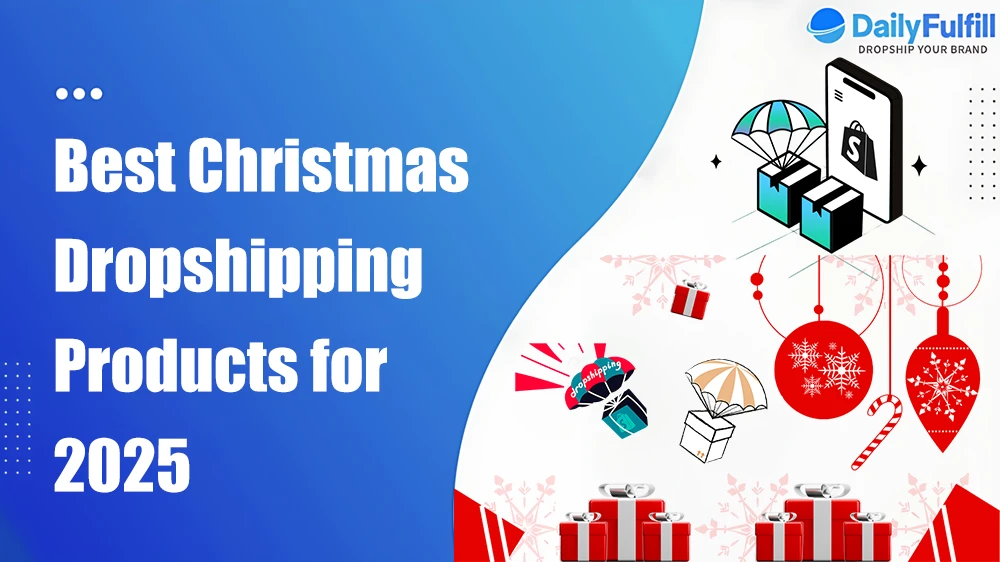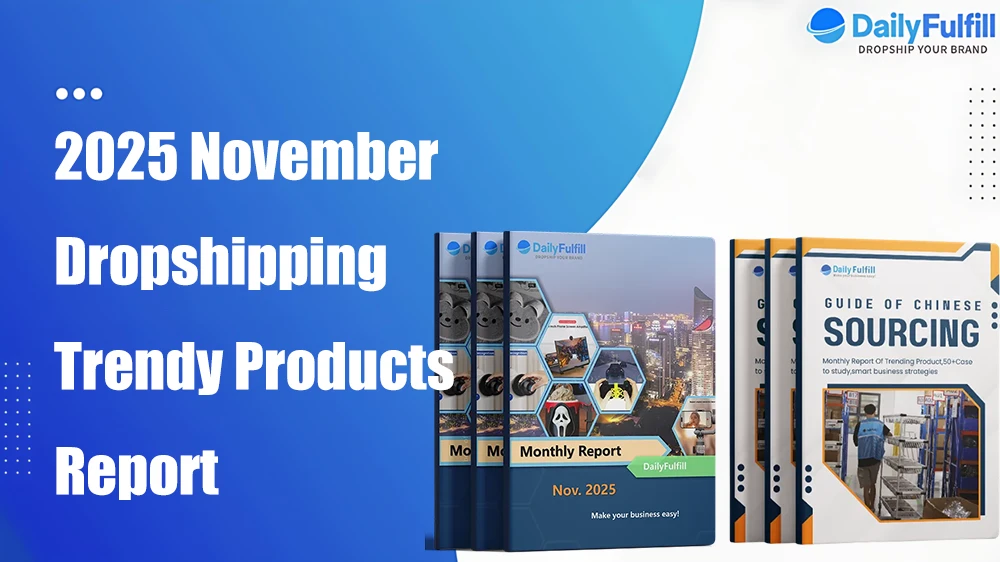
Shopify vs Amazon Which is better for Dropshipping in 2026
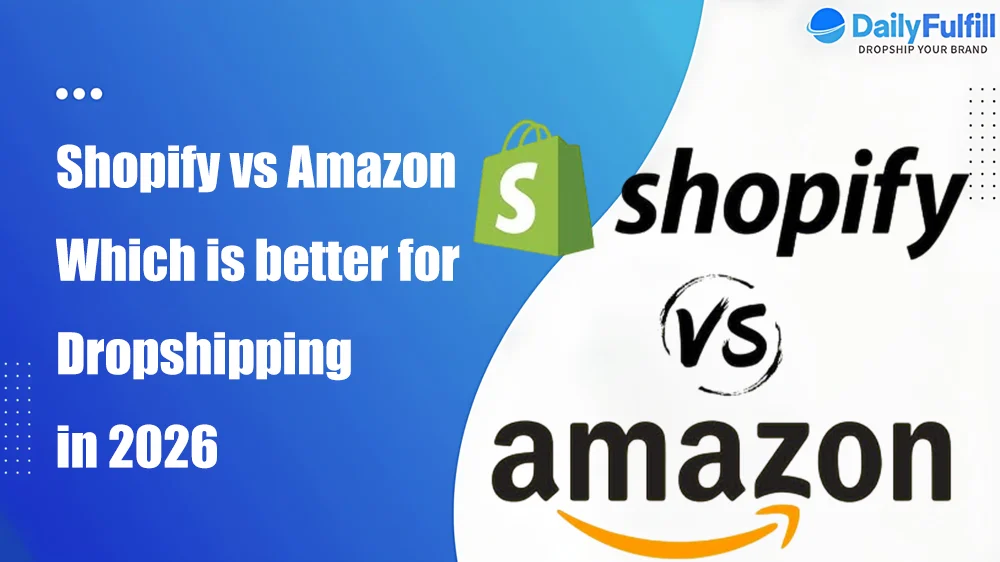
If you want the best dropshipping platform in 2026, it depends on your goals. Shopify lets you control your brand and how customers see it. Amazon gives you quick access to millions of shoppers. Amazon also helps with shipping and other tasks. The dropshipping market is growing fast. Experts think it will be worth over $470 billion in 2026.
In this article, DailyFulfill will compare Shopify Vs Amazon, look at profit margins, costs, branding, marketing tools, automation, and how many customers you want to reach.
Quick Verdict
If you want a quick answer, here it is: Shopify gives you more control over your brand and higher profit margins, while Amazon offers instant access to millions of shoppers and handles much of the heavy lifting. Your best choice depends on what matters most to you—brand building or fast sales.
Comparison Table
Feature | Shopify | Amazon |
|---|---|---|
Profit Margins | 20-30% (can reach 50%) | 10-30% (can reach 50-80% with FBA) |
Ease of Use | Easy setup, full control | Easy listing, strict rules |
Startup Costs | Low monthly fee, lower fees | Higher fees, referral charges |
Branding | Full control, custom store | Limited, Amazon branding first |
Customer Reach | You build your audience | Huge built-in audience |
Marketing | You handle all marketing | Amazon brings the traffic |
Automation | Many tools and apps | Amazon FBA automates shipping |
Fulfillment | Flexible, use any partner | FBA or self-fulfillment |
Scalability | High, you set the pace | High, but more competition |
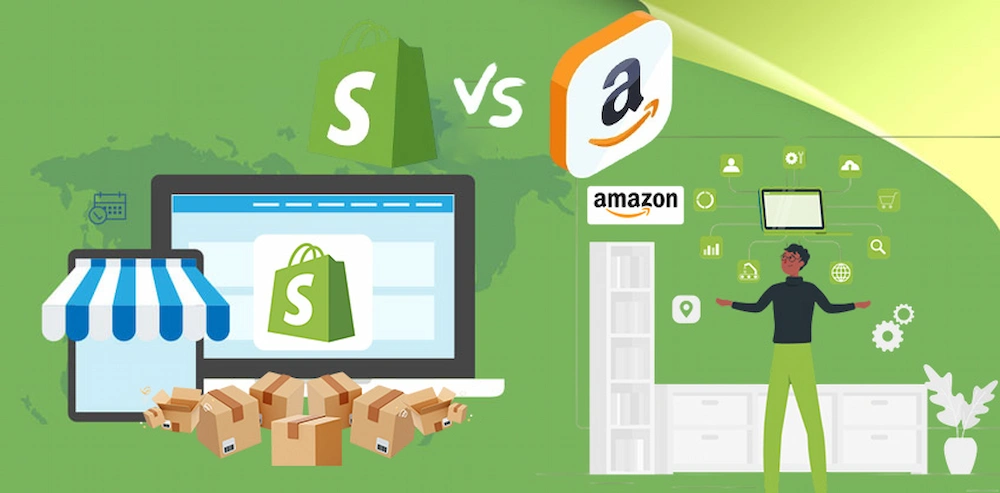
Dropshipping Shopify Vs Amazon
When you compare Dropshipping Shopify Vs Amazon, you see two different ways to run a business. Each platform has its own rules and special features. Both have things that make them hard or easy to use. Let’s look at what makes each one special.
Shopify Overview
Shopify lets you make your own online store. You can pick your website name and design your store. You set your own prices. You decide how your brand looks. You can choose colors, add your logo, and make your store match your ideas.
Here are some things that make Shopify stand out:
You keep your customer data. This helps you send emails and build relationships.
You choose how to market your store. You can use social media, ads, or emails to get visitors.
There is less competition. You pick your own niche and stand out from others.
You get paid every day, which helps with money flow.
You can choose how to ship orders. You can work with partners like DailyFulfill for fast shipping.
Shopify lets you change almost everything in your store. You can change the layout, add apps, and make your brand unique. If you want control and like to be creative, Shopify is a good choice.
Tip: If you want your brand to stand out and like being creative, Shopify gives you the tools you need.
Here’s a quick look at how Shopify’s business model works:
Feature | Shopify |
|---|---|
Traffic Acquisition | You bring in your own visitors |
Branding Control | You control branding and design |
Customer Access | You keep customer data |
Fulfillment | Flexible options |
Competition | Lower, you pick your own niche |
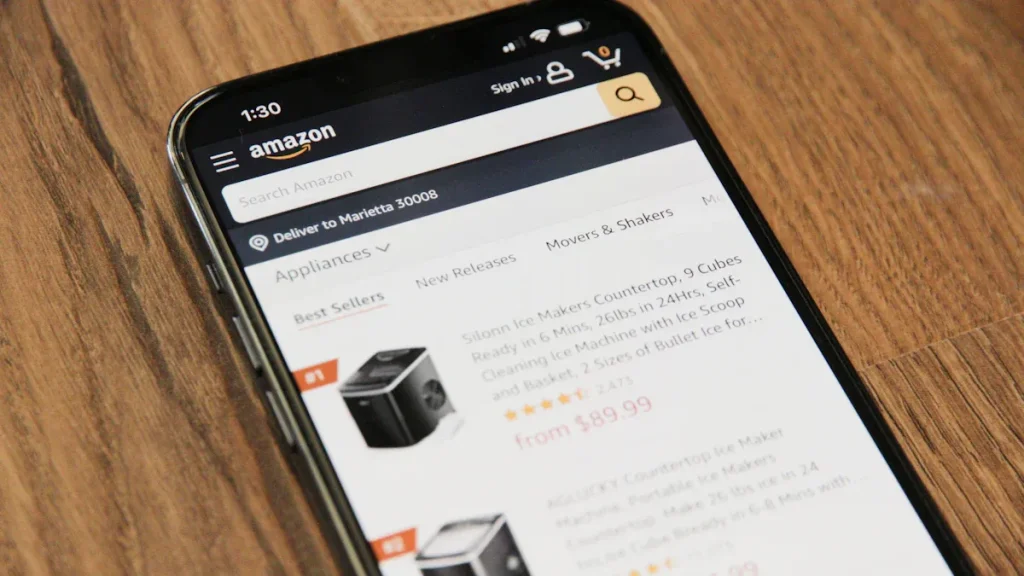
Amazon Overview
Amazon works in a different way. You list your products on a big marketplace. Millions of people shop there every day. You do not need to make your own website or find customers. Amazon brings shoppers to you.
Here are some things to know about Amazon:
You get access to a huge audience right away. Your products show up in searches fast.
You have less control over your brand. Your items are next to many others, and Amazon’s name is first.
Amazon keeps the customer data. You cannot follow up with buyers or make your own email list.
You compete with many other sellers, even Amazon itself.
Amazon pays you every two weeks, which can slow down your cash flow.
Amazon has FBA, which ships and handles returns for you. You can also use DailyFulfill for smoother orders.
Amazon’s business model is about speed and ease. You do not need to spend time on marketing or design. You just list your products and manage your stock.
Note: If you want fast sales and do not mind less control, Amazon’s big audience can help you grow fast.
Here’s a table to show the main differences in Dropshipping Shopify Vs Amazon:
Feature | Shopify | Amazon |
|---|---|---|
Traffic Acquisition | You bring in your own visitors | Built-in traffic from millions of shoppers |
Branding Control | You control branding and design | Limited branding; Amazon’s name is first |
Customer Access | You keep customer data | Amazon keeps customer data |
Fulfillment | Flexible options, partner with DailyFulfill | FBA gives fast shipping, setup needed |
Competition | Lower, you pick your own niche | High, many sellers for similar products |
Main Policy Differences
Shopify lets you control your marketing and branding. Amazon limits these choices.
Shopify gives you customer data for follow-up marketing. Amazon does not allow this.
Shopify pays you daily. Amazon pays every two weeks.
Amazon has strict rules and can suspend accounts quickly. Shopify is more stable.
Amazon’s seller support can be slow. Shopify gives better help.
When you compare Dropshipping Shopify Vs Amazon, think about what is most important to you. Do you want creative freedom and control? Shopify is a good choice. Do you want quick access to shoppers and easy shipping? Amazon makes it simple.
No matter which platform you pick, DailyFulfill can help you fulfill your dropshipping orders. You get fast, reliable shipping and support, so you can focus on growing your business.
Costs
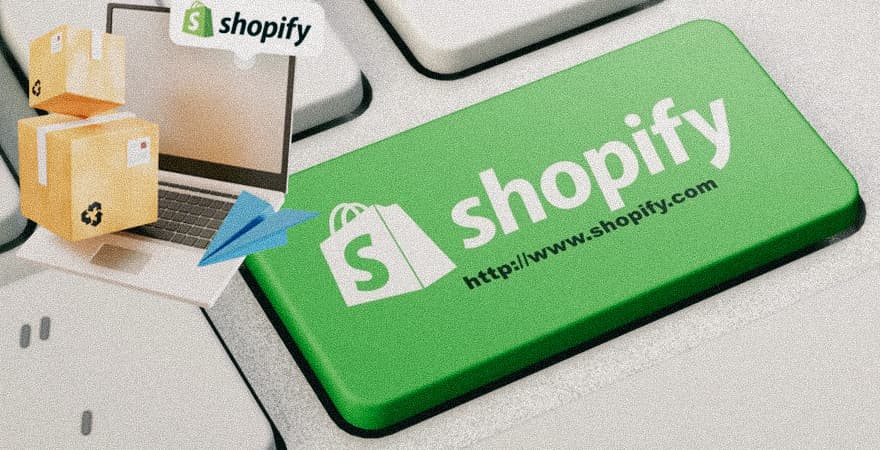
Shopify Fees
When you start a dropshipping store on Shopify, you pay a monthly subscription. The basic plan costs $29 each month. If you want more features, you can choose the Shopify plan for $79 or the Advanced plan for $299. You also need to register your business, which can cost between $50 and $800 depending on your state and business type. Buying a domain name costs about $16. Most dropshippers spend $100 to $300 each month on marketing, like paid ads. Shopify charges a transaction fee of 2.4% to 2.9% plus 30¢ per sale if you use Shopify Payments. If you use a third-party payment gateway, you pay a small extra fee.
Here’s a quick table to show the main costs:
Cost Category | Estimated Cost Range |
|---|---|
Basic Shopify Plan | |
Shopify Plan | $79/month |
Advanced Shopify Plan | $299/month |
Sole Proprietorship Registration | $50 to $200 |
LLC Registration | $100 to $800 |
Marketing (Paid Ads) | $100 to $300/month |
Domain Registration | $16 |
Tip: You can control your costs by choosing your plan and marketing budget. DailyFulfill can help you save time and money on order fulfillment.
Amazon Fees
Selling on Amazon works differently. You pay $0.99 per item if you use an individual account, or $39.99 each month for a professional account. Amazon takes a referral fee from every sale, which can be anywhere from 6% to 45% depending on your product category. You also pay for optional services, like FBA, and may face long-term storage fees. Startup costs range from $200 to $2,000, depending on your products and marketing. Ongoing expenses include sourcing products, branding, and advertising.
Here’s a simple breakdown:
Startup costs: $200 to $2,000.
Seller fees: 6% to 45% of each sale.
Monthly professional account: $39.99.
Extra fees for FBA, storage, and services.
Note: Amazon’s fees can add up quickly and take a bigger bite out of your profits. DailyFulfill can help you manage fulfillment costs and keep your business running smoothly.
Cost Comparison
When you look at Dropshipping Shopify Vs Amazon, you see big differences in how much you pay. Shopify uses a fixed monthly fee and clear transaction costs. Amazon’s fees change based on what you sell and how you fulfill orders. Shopify’s lower fees mean you keep more profit from each sale. Amazon’s higher referral fees and extra charges can reduce your margins, especially if you use FBA.
Platform | Pricing Model | Basic Cost | Transaction Fees | Commission on Sales | Additional Fees | Cost Predictability |
|---|---|---|---|---|---|---|
Shopify | Subscription | $25-$399/month | 2.4%-2.9% + 30¢ | None | Payment gateway fees | High |
Amazon | Mixed | $0.99/item or $39.99/month | 6%-45% referral fee | Referral fee per sale | FBA, storage fees | Low |
Shopify’s lower fees help you earn more profit.
Amazon’s fee structure can lower your margins, sometimes taking 10% to 15% of your income.
You can predict your costs better with Shopify.
No matter which platform you choose, DailyFulfill can help you fulfill your dropshipping orders and keep your costs under control.

Profitability
Shopify Margins
When you run a dropshipping store on Shopify, your profit margins depend on many things. You get to set your own prices, but you also need to watch your costs. Here are some key factors that can change your profits:
Product selection matters a lot. Niche products often bring higher margins.
Supplier pricing affects how much you make. Better deals mean more profit.
Shipping costs can eat into your earnings. Try to keep these low.
Advertising and marketing spend can add up fast. Make sure you get good results for your money.
Customer acquisition and retention help you earn more over time.
Competition can force you to lower prices, which cuts into your margins.
Operational efficiency, like using smart tools, saves money.
Handling returns and refunds well protects your profits.
Payment processing fees add up, so keep an eye on them.
If you sell internationally, currency exchange rates can change your final profit.
Shopify charges a monthly fee and a small payment processing fee. You keep more of each sale compared to Amazon. You need to bring in your own customers, but you also get to keep your customer data. This helps you build loyalty and repeat sales.
Tip: If you want to boost your margins, focus on finding the right products and keeping your costs low. DailyFulfill can help you save on fulfillment and make your business run smoother.
Amazon Margins
Selling on Amazon works differently. You get access to a huge audience, but you pay for it. Amazon takes a referral fee from every sale, usually between 8% and 15%. If you use FBA, you pay extra for storage and shipping. These fees can lower your profit margins, especially if you sell low-priced items.
Amazon’s fees add up quickly. You need to price your products at least three times their cost to stay profitable.
The more you sell, the more you pay in fees. High volume can mean high costs.
Competition is tough. Many sellers offer similar products, which can push prices down.
Amazon’s built-in audience helps you make sales faster, but you have less control over your brand and customer data.
Note: To keep your profits healthy on Amazon, watch your costs and choose products with enough margin to cover all fees. DailyFulfill can help you manage fulfillment costs and keep your business running smoothly, no matter which platform you choose.
Dropshipping Shopify Vs Amazon both offer ways to make money, but your profit depends on how well you manage costs and pick the right products.
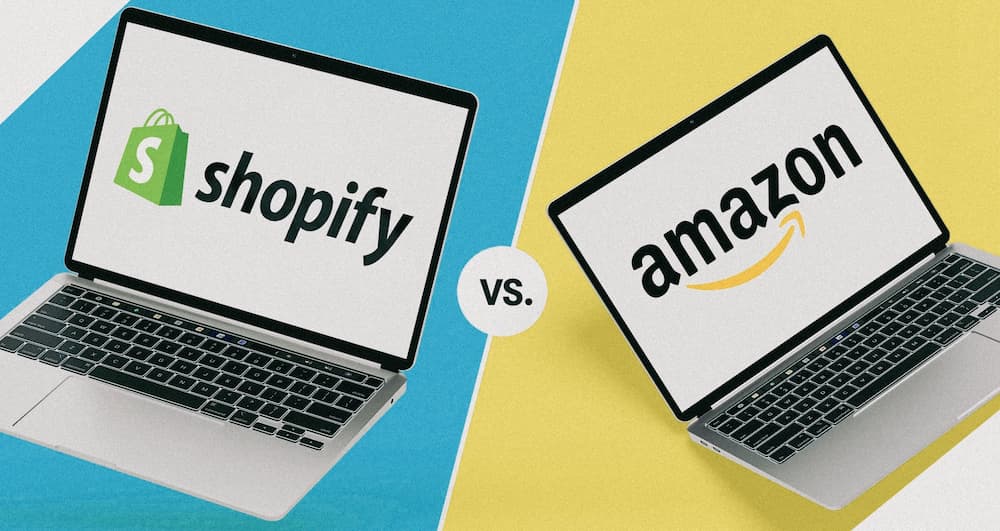
Branding
Shopify Branding
When you use Shopify for dropshipping, you get full control over your brand. You decide how your store looks, feels, and sounds. You can pick your own colors, logo, and layout. You can even tell your story and connect with your customers in a personal way. This freedom helps you build a brand that stands out and lasts.
Here’s how you can build a strong brand on Shopify:
Define your mission and values. Maybe you want to show that your store cares about the planet or supports local makers.
Create a memorable logo and design. Use design tools to make your store look professional and unique.
Develop a consistent voice. Talk to your customers in a way that matches your brand’s personality.
Tell your story. Share your journey and let people know why you started your business.
Offer exceptional customer service. Respond quickly and make sure your customers feel valued.
Shopify lets you keep your customer data. You can send emails, offer special deals, and build loyalty. You control every detail, from your homepage to your checkout page. If you want to grow a brand that people remember, Shopify gives you the tools to do it.
Amazon Branding
Amazon works differently. You sell your products on a huge marketplace, but you have less control over your brand. Your products show up next to many others. Amazon’s name is always front and center. You can add your logo and product photos, but you cannot change the look of your store much.
Here’s what branding looks like on Amazon:
Limited store customization. You use Amazon’s templates and rules.
Your brand shares space with competitors. Shoppers see many similar products.
Amazon keeps customer data. You cannot build your own email list or send follow-up messages.
Your story and values are harder to share. Most shoppers focus on price and reviews.
If you want quick sales and do not mind less control, Amazon’s big audience helps you reach more people fast. If you want to build a brand for the long run, Shopify gives you more options.
Marketing
Shopify Marketing
When you use Shopify for dropshipping, you get a blank canvas. You build your store, but you also need to bring in shoppers. Shopify does not give you a built-in audience. You must work to get people to visit your site. You can use digital marketing strategies like SEO, paid ads, influencer partnerships, and email campaigns. These tools help you reach your target customers, but you need to learn how to use them well.
Here’s what you get with Shopify marketing:
Full control over your brand and store design.
The ability to collect customer emails and build long-term relationships.
Multiple payment options for your customers.
Flexibility to try new marketing ideas.
You need to invest time and money in marketing. You might spend on ads or work on social media to get noticed. This effort pays off because you own your customer list and can keep selling to them. If you want help with order fulfillment, DailyFulfill can support your business and let you focus on growing your audience.
Amazon Marketing
Amazon works differently. You do not need to worry about finding shoppers. Amazon brings millions of buyers to its marketplace every day. Your products show up in searches right away. This gives you instant visibility, but you have less control over how your brand looks.
To succeed on Amazon, you need to:
Optimize your product listings with good photos and keywords.
Get positive customer reviews.
Offer competitive prices.
Amazon’s built-in audience means you can make sales quickly. You do not need to spend much on marketing, but you face high competition. Amazon keeps the customer data, so you cannot build your own email list. If you want to handle shipping smoothly, DailyFulfill can help you fulfill orders on Amazon, too.
Tip: Shopify lets you build your brand and customer base, but you must work harder to get traffic. Amazon gives you shoppers right away, but you compete with many sellers and have less control over your brand.
Automation
Shopify Tools
Shopify has many ways to help you automate your dropshipping business. You can use built-in tools and apps to save time and avoid mistakes. Shopify Flow lets you set up your own rules for your store. You can make it tag orders, send emails, or update inventory by itself. This is good if you want to control how your store works.
AutoDS is an app that helps with pricing, inventory, and orders. It changes your stock and prices for you, so you do not have to check them all the time. Spocket connects you with suppliers in the US and EU. It keeps your inventory updated and helps you ship fast. SaleHoo helps you find products and suppliers. It also gives training if you are new to dropshipping.
Here are some popular Shopify automation tools:
Shopify Flow: Makes custom rules for tagging, emails, and inventory.
AutoDS: Handles pricing, inventory, and orders automatically.
Spocket: Finds good suppliers and updates your inventory.
SaleHoo: Helps you find products and manage suppliers.
Of course, you can use DailyFulfill with Shopify too.
Amazon Tools
Amazon has strong automation tools, but they work differently. If you use Fulfillment by Amazon (FBA), Amazon stores, ships, and handles returns for you. You do not need to pack or send orders yourself. Amazon Multi-Channel Fulfillment (MCF) lets you use Amazon’s network to ship orders from other places.
CS Amazon Product Sync helps you manage products in different regions. AutoDS works with Amazon too, so you can automate pricing and inventory. WebBee and ByteStand give you more features, like global support and blocking certain carriers.
Here are some key Amazon automation tools:
Amazon FBA and MCF: Handle storage, shipping, and returns for you.
CS Amazon Product Sync: Manages products in many regions.
AutoDS: Automates pricing and inventory for Amazon sellers.
WebBee/ByteStand: Help with orders and inventory management.
Amazon’s automation tools help you reach more customers and keep your business running well. You can use DailyFulfill to handle dropshipping orders, no matter where you sell.
Tip: Both Shopify and Amazon have great automation tools. Pick the ones that match your business style. DailyFulfill can help you on both platforms and make order fulfillment easy.
Fulfillment

Shopify Process
Shopify gives you lots of choices for your dropshipping store. You do not have to buy products before you sell them. You only pay for items after someone orders from your store. This helps you start with less money and less risk. Your suppliers send products straight to your customers. You get to pick how your store looks and how you talk to shoppers. You can choose which suppliers to use and switch them if you want.
You control your brand and how customers feel about your store. You answer customer questions and solve problems yourself. This can help you build strong relationships with buyers. But the service can change depending on how fast you or your suppliers reply.
Tip: Shopify is a good choice if you want to control your store and brand.
Here’s a quick table that shows how Shopify dropshipping and Amazon FBA are different:
Aspect | Dropshipping (Shopify) | Amazon FBA |
|---|---|---|
Capital Requirements | Minimal capital needed | Requires inventory investment |
Profit Margins | Generally lower profit margins | Higher fulfillment costs |
Inventory Management | No inventory until sale | Amazon handles warehousing |
Fulfillment Control | Less control over fulfillment | Greater control with logistics |
Amazon FBA
Amazon FBA does most of the work for you. You send your products to Amazon’s warehouse. Amazon stores, packs, and ships the orders for you. They also handle returns and some customer service. This makes things fast and easy. Many people trust Amazon for quick shipping.
You do not need to pack or ship anything yourself. Amazon’s system works very well. You can spend more time finding products and growing your store. But you must buy products before you sell them. Amazon charges fees for storage and shipping, which can lower your profits.
Amazon FBA takes care of packing, shipping, and storage, so orders arrive fast.
Delivery times are often better, but Amazon’s customer support is not always the same.
With Shopify, you handle customer service, so quality depends on you and your suppliers.
Note: Amazon makes fulfillment simple, but Shopify lets you control your brand and service.
No matter which platform you use, DailyFulfill can help you ship your dropshipping orders. DailyFulfill works with both Shopify and Amazon sellers, making your order process easier and helping you keep customers happy.
Scalability
Shopify Growth
If you want to grow your dropshipping business, Shopify gives you a lot of room to expand. You can build your own brand and make your store look unique. As your sales go up, you can add new products, try different marketing ideas, and even open more stores. You own your customer list, so you can send emails and keep people coming back. Investors like stores that have strong brands and loyal customers. You can set your own prices and keep more profit as you get better at selling.
Here’s a quick table to show how Shopify and Amazon compare for scaling your business:
Platform | Scalability Focus | Key Advantage |
|---|---|---|
Shopify | Long-term asset building | Better profit margins and brand ownership |
Amazon | Operational scalability | Speed to market and exposure without building from scratch |
Shopify lets you grow at your own pace. You can test new ideas and change your store anytime. If you want to build something that lasts, Shopify is a smart choice.
Tip: DailyFulfill helps you handle more orders as your business grows. You can focus on scaling up while we take care of fulfillment.
Amazon Growth
Amazon makes it easy to reach lots of customers fast. You can list your products and start selling right away. The platform handles shipping and returns, so you can focus on finding new products. If you want to grow quickly, Amazon’s huge audience gives you a big boost. You can sell in many categories and reach buyers all over the world.
But there are some risks you need to watch out for:
Amazon has strict rules. If you break them, your account can get suspended.
The marketplace is crowded. You might have to lower your prices to compete.
You depend on suppliers for inventory. If they run out, you lose sales.
Long-term growth can be tough if you cannot control your brand or customer data.
Amazon helps you scale fast, but you need to manage risks and keep your business steady. If you want help with shipping and order management, DailyFulfill can support you on Amazon too.
Note: Think about your long-term goals. Shopify is better for building a brand and keeping profits high. Amazon is great for quick growth and reaching more customers, but you need to watch out for competition and account issues.
Pros and Cons
Shopify Pros and Cons
Shopify lets you change your store and make it your own. You can pick how your store looks and build your brand. Here are some good and bad things about Shopify:
Pros:
You choose your store’s look and how people shop.
Shopify has tools to help you find customers.
You can see reports to know what works best.
The platform is safe and runs well, so you do not worry about tech problems.
You can get help any time, in many languages.
You can change your SEO and web addresses to help people find you.
Cons:
You must bring shoppers to your store, often by paying for ads.
Monthly costs can be high if you want extra features.
Some changes need you to learn Shopify’s Liquid code.
Fees for sales and credit cards can lower your earnings.
DailyFulfill helps you send orders fast and makes dropshipping easier, no matter which platform you use.
Amazon Pros and Cons
Amazon lets you sell to lots of people right away, but you lose some control. Here are the main good and bad points:
👍 Pros | 👎 Cons |
|---|---|
Many sellers means lots of competition | |
Start with little money and less risk | Amazon’s fees can lower your profits |
No need to pay for storage | You cannot control product quality much |
Easy to grow and use automation | You cannot control shipping or stock |
Reach many customers quickly | Problems with inventory can happen |
Work from anywhere you want | Hard to make your brand stand out |
If you want to sell fast and reach more people, Amazon is simple. If you want to make a special brand, Shopify gives you more choices. DailyFulfill helps you ship orders quickly and keeps your dropshipping business running smoothly.
Choosing between Shopify and Amazon depends on your style. If you want to build a brand and control your store, Shopify fits you. If you want fast sales and a big audience, Amazon works better.
Think about your goals and experience. Make a list of what matters most to you. No matter what you pick, DailyFulfill can help you fulfill your dropshipping orders. Ready to start? Get a free quote and grow your business today! 🚀
DailyFulfill is your Best Dropshipping Partner
- 24/7 customer support
- 100% quality guarantee
- 1400+ professional clients
- 8400 m² fulfillment center
- 59960+ Sku of products
- 12+ dropshipping experience

